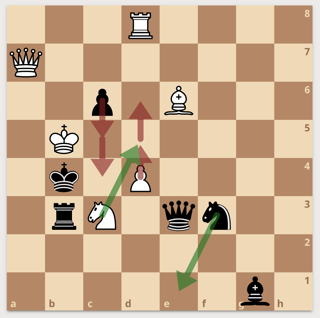TL;DR: The minimum number of moves is
9.
Let's start by finding the allowed move pairs:
Obviously, a bishop's move can be matched by an equal and opposite bishop's move, and so on. There are also some "special couples" where black and white can move different pieces. Given the weights
King=10g. Queen=8g. Rook=5g. Bishop=4g. Knight=4g. Pawn=2g.
we can go through every possible integer weight and see if you can make that weight by adding up pieces of one kind. (Although not more than the maximum vertical move of that piece type). This gives us the following equal weight combinations:
4: ♘ = ♝ = ♙♙
8: ♕ = ♗♗ = ♞♞
10: ♔ = ♜♜
16: ♛♛ = ♗♗♗♗
20: ♖♖♖♖ = ♝♝♝♝♝
24: ♛♛♛ = ♗♗♗♗♗♗
32: ♛♛♛♛ = ♗♗♗♗♗♗♗♗
40: ♕♕♕♕♕ = ♜♜♜♜♜♜♜♜
Of course, we can only move one piece at a time, so we'll just interpret the number of pieces as the vertical distance moved, and we have found all the balance-preserving move pairs.
Then, let's put some limits on the optimal solution.
- If every piece just took the minimum number of moves to reach the other side, moving on top and through other pieces, we'd need 8 white moves and 7 black moves.
- Because black needs two one-square pawn moves, white must make a useless pawn move to match it up
- Because white has to make 9 moves, black will need as many moves to balance the board.
So the optimum cannot be better than 9 moves. The above analysis also tells us that black can basically waste two moves without affecting the result.
Let's see if we can't get there. Start by clearing up some space. (Sorry about the notation, Lichess won't let me ignore checks)

1. Be6 Nf3
2. Rd8 Bh2
Then, juggle the kings and the rook:

3. Kc4 Rb3
4. Kb5 Kb4
Next, do the queens, and very importantly, the double pawn move (otherwise the white pawn would end up blocking the white knight).

5. Qa7 Qe3
6. d4 Bg1 (we can afford to waste a black move)
and finally, do the pawns and the final white knight (and the balancing black move):

7. d5 c5
8. d6 c4
9. Nd5 Ne1 (Omit black's last move if final balancing is not necessary)
And there we have it: an optimal solution with an otherwise unnecessary black move as the final balancing step.





